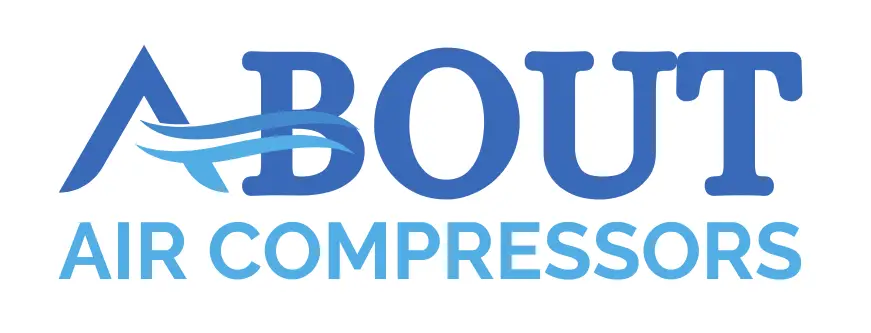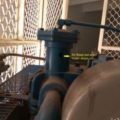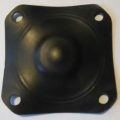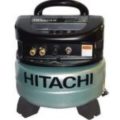Hey! This site is reader-supported and we earn commissions if you purchase products from retailers after clicking on a link from our site.
Leaks can be a significant source of wasted energy in air compressor systems, resulting in additional costs. They also contribute to a drop in system pressure, which can make any air tools connected operate less efficiently.
This article will provide you with all the crucial information about air compressors leaking air, how to find them, and fix them.
Table of Contents
- Why Is My Air Compressor Leaking?
- How to Detect Air Compressor Leaks
- How to Fix Air Compressor Leaks
- FAQs (Frequently Asked Questions)
- Useful Pages on Air Compressor Leaks
Why Is My Air Compressor Leaking?
Air compressor leaks can happen due to several reasons and appear in many parts of a compressed air system. The most common leaks found on air compressors are:
- Couplings
- Disconnects
- Filters
- Fittings
- Flanges
- Hoses
- Lubricators
- Pipe joints
- Regulators
- Thread sealants
- Tubes
How to Detect Air Compressor Leaks
One of the simplest ways to detect air compressor leaks, if you cannot hear or feel the air leaking from the system, is to use soap on the connections to see if any bubbles form.
To do so, place a tablespoon of liquid dish soap, or hand soap, into a cup of lukewarm water from your tap. Apply the solution onto the connections on your air compressor one at a time, making sure you include the end of the coupler on the air hose.
If there is a leak at any of these connections, bubbles will form where the air is escaping your air compressor system. If you find a leak using this method, tighten the fitting and then test it again with the bubble solution.
If you want high accuracy, the best way to detect air compressor leaks is by using an ultrasonic acoustic detector. These portable devices consist of directional microphones, amplifiers, and audio filters, that enable them to recognize high-frequency hissing sounds that are generated by air leaks with either visual indicators or the use of earphones.
Here’s an example of an ultrasonic acoustic detector readily available on Amazon!
- 1.Detecting cables, electrical lines-water/gas supply pipelines buried in wall or earth
Prices pulled from the Amazon Product Advertising API on:
Product prices and availability are accurate as of the date/time indicated and are subject to change. Any price and availability information displayed on [relevant Amazon Site(s), as applicable] at the time of purchase will apply to the purchase of this product.
Ultrasonic leak detection is very versatile and can be adapted to a variety of leak detection scenarios. Its principle is simple, they focus on the ultrasonic elements found in the turbulent white noise that is created as a leak flows from a high-pressure laminar flow to a low-pressure turbulent flow.
Ultrasonic detectors are unaffected by background noises in the audible range because they’re filtered out, which allows the leaks to be detected in even the loudest environments. They offer versatility, speed, ease of use, and generally can be used with minimum training. Anyone can pick on up and be competent within 10 to 15 minutes.
Due to the directional transmission nature of ultrasound, the signal is loudest at its source. So if you use the detector and scan around areas, it is possible to very quickly locate a leak and pinpoint its location.
The bubble solution comes in handy where using an ultrasonic detector is not possible, but it may not always be accurate. Therefore, it is recommended to pick up an ultrasonic detector and have one at hand to ensure you are able to detect leaks imminently.
How to Fix Air Compressor Leaks
In some cases, stopping or repairing air compressor leaks can be as simple as tightening connections. In other situations, it may require a more complex process, where you will need to replace the equipment such as couplings, fittings, pipe sections, hoses, and drains or traps.
A lot of the time the leak may be down to improperly applied thread sealant. To repair an air compressor leak and avoid them in the future, you should install high-quality fittings, connects, hoses, tubing, and when doing so, apply the appropriate thread sealant properly to ensure a leak-free connection.
If equipment connected to the system is no longer in use, you should isolate them with a valve within the distribution system, otherwise, they may become an additional source of leaks.
One way to reduce the leaks, if you cannot detect them, is to lower the air pressure demand of the system. The lower the pressure differential across a leak, the lower the rate of flow, and the lower the leakage rate. Yes, this will minimize the leakage sure, and help with cost savings, but you’re best investing in a leak detector and fixing the issue.
How to Fix Compressor Coupling, Disconnect & Fitting Leaks
First of all, you should check your compressed air system thoroughly to ensure that the coupling, disconnect, fitting, or quick connect is the cause of the leak. If it is, there are several ways to fix the issue.
I would advise that if there’s any evident damage or no seal issue, replace your component with a new one! It typically will not be that expensive, and it’ll be much more worthwhile.
Visit our Air Compressor Quick Connect Leaks – Why & How to Fix for more information!
How to Fix Compressor Hose Leaks
To fix an air compressor leaky hose, you need to follow the 5 following steps:
- Locate the leak
- Cut the hose
- Place coupler fitting inside hose
- Tighten hose clamps
- Wrap plastic bag around
For more details on what each step requires, visit our How To Fix A Leaky Air Compressor Hose guide!
How to Fix Compressor PRV Leak
PRV’s leaking air means that it blows off just before the air compressor reaches the set point to cut out, so it must be considered that the PRV’s has too low of cracking pressure.
While you cannot adjust the basic PRV, you can acquire ones that blow off at a pressure level that is higher than the normal cut-out of the pressure switch. For more information, visit our PRVs keep leaking – Air Compressor Pressure Relief Valve Leaking article!
How to Fix Compressor Pressure Switch Leak
A common misconception when air is leaking and people instantly think their pressure switch is at fault is actually due to a faulty check valve, which is causing the unloader valve to release air. For more information, read the next point on the unloader valve, and visit this reader problem and solution page on air leaking at the pressure switch end of the compressor tube!
How to Fix Compressor Regulator Leak
The most likely cause of a regulator leak is a cracked diaphragm inside the regulator. When this diaphragm cracks, air can flow through it, up the regulator housing, and out of the relieving hole or flow out from under the adjustment knob. It’s sometimes difficult to just replace the diaphragm mechanism, so it is generally advised to purchase a new regulator.
For more information on this, visit our Why A Compressor Regulator Leaks guide!
How to Fix Compressor Tank Leak
In some situations, it may not be safe to conduct a repair on an air compressor tank. Depending on the severity, it may be better to replace the tank, or if the cost is similar, then you should buy a new air compressor. I will strongly advise consulting an expert before any repair due to the evident safety hazards.
You can, however, if it is safe to do so, use a brazing torch to apply direct heat on the leakage area and then place a brazing rod on it to rebuild the area. For more information on this method and additional information on tank fitting leaks, please visit our How To Fix An Air Compressor Tank Leak page!
How to Fix Compressor Unloader Valve Leak
If air leaks or bleeding from the unloader valve continuously, there is a good chance the tank check valve has either failed or not been seated properly. The compressed air in the tank is forced to bleed back up out of the tank to the unloader valve and escape to the atmosphere.
When the tank check valve isn’t seated tightly or at all, compressed air will continue to bleed out until the tank pressure reaches the cut-in pressure setting on the pressure switch, and then the air compressor will start to pump up the pressure in the tank again. Therefore, the check valve would need replacing.
For more detailed information visit our Air Compressor Unloader Valve Explained, Adjustment & Common Problems guide!
FAQs (Frequently Asked Questions)
Your air compressor can be leaking air for a variety of reasons and these leaks may appear in various parts of the compressed air system. The most common leaks found on air compressors are at the couplings, disconnects, filters, fittings, flanges, hoses, lubricators, pipe joints, regulators, thread sealants, and tubes/piping.
It may be possible to stop or repair an air compressor leak by simply tightening connections. In other situations, it may require a far more complex process, where you will need to replace the equipment that is causing the leak.
If your air compressor is not holding air, it’s likely you have a leak somewhere. One of the most common reasons air compressors won’t hold air and don’t build pressure is a faulty reed valve, which causes air to flow out of the air intake.
If you cannot already hear or feel the air leaking from your air compressor, one of the simplest ways to detect air compressor leaks is to use soap on the connections to see if any bubbles form. If bubbles form, you know you have a leak at that part of the system! If you want very high accuracy to detect air compressor leaks then I will recommend purchasing an ultrasonic acoustic detector. These devices can detect almost any leak and even in loud environments.
Useful Pages on Air Compressor Leaks
- Compressed Air Leaks – How to Find And Fix Leaks In compressed Air System
- Air Compressor Quick Connect Leaks – Why & How to Fix
- How To Fix An Air Compressor Tank Leak
- How To Fix A Leaky Air Compressor Hose – Stop Air Compressor Hose Leaking
- PRVs keep leaking – Air Compressor Pressure Relief Valve Leaking
If you have any questions regarding air compressors leaking air, please leave a comment below, with a photo if applicable, so that someone can help you!





![Emglo Air Compressor Leaking Air? Solutions & Causes [guide]](https://www.about-air-compressors.com/wp-content/uploads/2019/02/Emglo-Air-Compressor-Leaking-Air-Solutions-Causes-GUIDE-120x120.jpg)
